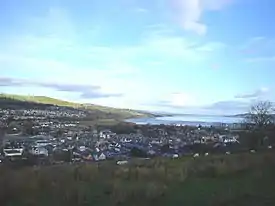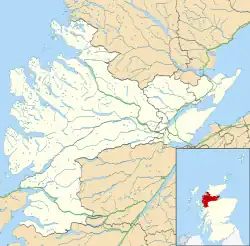Dingwall
Dingwall (Scots: Dingwal,[2] Scottish Gaelic: Inbhir Pheofharain[3] [ˈiɲɪɾʲ ˈfjɔhəɾan]) is a town and a royal burgh in the Highland council area of Scotland. It has a population of 5,491. It was an east-coast harbour that now lies inland. Dingwall Castle was once the biggest castle north of Stirling. On the town's present-day outskirts lies Tulloch Castle, parts of which may date back to the 12th century. In 1411 the Battle of Dingwall is said to have taken place between the Clan Mackay and the Clan Donald.
Dingwall
| |
|---|---|
 Looking across Dingwall to the Cromarty Firth | |
 Dingwall Location within the Ross and Cromarty area | |
| Population | 5,360 (mid-2020 est.)[1] |
| OS grid reference | NH550587 |
| • Edinburgh | 123 mi (198 km) |
| • London | 454 mi (731 km) |
| Council area | |
| Lieutenancy area | |
| Country | Scotland |
| Sovereign state | United Kingdom |
| Post town | DINGWALL |
| Postcode district | IV7, IV15, IV16 |
| Dialling code | 01349 |
| Police | Scotland |
| Fire | Scottish |
| Ambulance | Scottish |
| UK Parliament | |
| Scottish Parliament | |
| Website | http://www.dingwallcc.com |
History

Its name, derived from the Scandinavian Þingvöllr (field or meeting-place of the thing, or local assembly; compare Tynwald, Tingwall, Thingwall in the British Isles alone,[4] plus many others across northern Europe), preserves the Viking connections of the town; Gaels call it Inbhir Pheofharain (pronounced [iɲiɾʲˈfjɔhəɾaiɲ]), meaning "the mouth of the Peffery" or Baile Chàil meaning "cabbage town".[5][6]
The site of the Þingvöllr, and of the medieval Moothill, thought to have been established by the Vikings after they invaded in the 8th century, lies beneath the Cromartie memorial.[7]
In the early Middle Ages Dingwall Castle, which was established in the 11th century, was reputed to have the largest castle north of Stirling.[8]
King Alexander II created Dingwall a royal burgh in 1226, the burgh becoming the seat of the Earls of Ross. James IV renewed its royal burgh charter in 1497.[9] On the top of Knockfarrel (Scottish Gaelic: Cnoc Fhearghalaigh), a hill about three miles (five kilometres) to the west, stands a large and very complete vitrified fort with ramparts.[10]
An obelisk, 51 feet (16 m) high, was erected over the grave of George Mackenzie, 1st Earl of Cromartie, near the parish church of St Clement after he died in 1717. It was affected by subsidence, becoming known as the "Leaning Tower", and was later replaced by a much smaller replica.[11]
Dingwall Town Hall, which dates back to 1745, still survives.[12]
James Gillanders of Highfield Cottage near Dingwall, was the Factor for the estate of Major Charles Robertson of Kincardine and, as his employer was then serving with the British Army in Australia, Gillanders was the person most responsible for the mass evictions staged at Glencalvie, Ross-shire in 1845. A Gaelic-language poem denouncing Gillanders for the brutality of the evictions was later submitted anonymously to Pàdraig MacNeacail, the editor of the Canadian Gaelic column in which the poem was later published in the Nova Scotia newspaper The Casket. The poem, which is believed either to be or to draw upon eyewitness accounts, is believed to be the only Gaelic language source of information relating to the evictions in Glencalvie.[13]
Dingwall formerly served as the county town of Ross and Cromarty: the headquarters of Ross and Cromarty County Council, established in 1889, was County Buildings in Dingwall.[14]
The Ferry Road drill hall was completed in 1910.[15]
As a result of storms in late October 2006, Dingwall was subject to widespread flooding the aftermath of which left the town and much of the Highlands north of Inverness, including the A9 and Far North Line, cut off for a time [16] In August 2019 the town was once again flooded.[17]
Dingwall's Post Office was named the UK's most improved delivery office of the year in Royal Mail’s 2021 Awards.[18]
Geography
Dingwall lies near the head of the Cromarty Firth where the valley of the Peffery unites with the alluvial lands at the mouth of the Conon, 14 miles (23 km) northwest of Inverness. The town contains a particularly short canal, the Dingwall Canal, also known locally as the River Peffery.[19]
Sport
Dingwall is the home of football team Ross County, who won promotion to the Scottish Premier League in 2012 and finished the 2012/13 season in fifth place. Despite the town's small population, Ross County attract sizeable crowds to Victoria Park from across the whole surrounding area. The team reached the 2010 Scottish Cup Final, having knocked out Celtic in the previous round.[20]
Ross County won their first piece of major silverware in 2016, winning the Scottish League Cup by beating Hibernian 2–1 in the final.[21]
Transport
Dingwall railway station has been on what is now called the Far North Line since about 1865. It also serves the Kyle of Lochalsh Line.[22]
Dingwall is on the former main road route to the north Highlands (A9). Since the completion of the Cromarty Bridge in 1979, the main road has bypassed Dingwall. Heading west, the A834 joins the A835 road which is the main route to the north west Highlands, including Ullapool.[23]
Education
Dingwall Academy is the secondary school serving the town and the wider area.[24]
The Highland Theological College is located within the town, housed in a former Scottish Hydro Electric office.[25]
Parliamentary Burgh

Dingwall was a parliamentary burgh, combined with Dornoch, Kirkwall, Tain and Wick in the Northern Burghs constituency of the House of Commons of the Parliament of Great Britain from 1708 to 1801 and of the Parliament of the United Kingdom from 1801 to 1918. Cromarty was added to the list in 1832. The constituency was a district of burghs known also as Tain Burghs until 1832, and then as Wick Burghs. It was represented by one Member of Parliament (MP). In 1918 the constituency was abolished and the Dingwall component was merged into the county constituency of Ross and Cromarty which was itself abolished in 1983.[26]
Notable people
- James Fraser of Brea theologian and prisoner on the Bass Rock[27]
- Prof James Alexander MacDonald (1908–1997) botanist, born and raised in Dingwall.[28]
- Major General Sir Hector Archibald MacDonald, Son of a local Crofter at Rootfield, Dingwall.[29]
- John M'Gilligen of Fodderty who held conventicles in houses throughout the county[30]
- John Kennedy of Dingwall, Free Church of Scotland minister
- Rev Duncan Leitch, Moderator of the General Assembly of the Free Church of Scotland in 1952[31]
- Julie Fowlis, a folk singer and multi-instrumentalist[32]
- Kate Forbes, member of the Scottish Parliament for Skye, Lochaber and Badenoch and former Cabinet Secretary for Finance at the Scottish Government. She was born and went to school in Dingwall.[33][34]
- Thomas Simpson (explorer), Arctic explorer and accused murderer (1808–1840)[35]
- Willie Logan, civil engineer and founder of aviation company Loganair[36]
- Colin Calder, founder of the Club Atletico Rosario Central - Argentina on December 24, 1889[37]
Religion
Churches
- St Lawrence's Church, opened in 1902.[38]
References
- "Mid-2020 Population Estimates for Settlements and Localities in Scotland". National Records of Scotland. 31 March 2022. Retrieved 31 March 2022.
- "Scots Language Centre: Scottish Place Names in Scots". Scotslanguage.com. Retrieved 10 October 2012.
- "Ainmean-Àite na h-Alba ~ Gaelic Place-Names of Scotland". Gaelicplacenames.org. Archived from the original on 25 April 2012. Retrieved 10 October 2012.
- Fellows Jensen, Gillian (1993). "'Tingwall, Dingwall and Thingwall'. North-Western European Language Evolution, 21:22". Odense University Press. pp. 53–67.
- "Dingwall". Gaelic Place names of Scotland. Retrieved 24 June 2017.
- "The illustrated Gaelic dictionary". Retrieved 10 October 2012.
- MacDonald, D. D. "Investigating Dingwall as Þingvöllr" (PDF). The Highland Council. Retrieved 9 October 2022.
- Norman Macrae, Romance of a Royal Burgh: Dingwall's Story of a Thousand Years Publisher: EP Publishing Ltd. ISBN 0715810715
- Byrom, Bernard (2022). Old Dingwall. Catrine: Stenlake Publishing Ltd. p. 3. ISBN 978-1-84033-930-7.
- G.E. Mitton (1925). Black's Guide to Scotland. Рипол Классик. p. 427. ISBN 978-5-88070-219-0. Retrieved 7 June 2019.
- Clough, Monica. "The Cromartie Estate, I66o-1784: Aspects of Trade and Organisation" (PDF). p. 89.
- Historic Environment Scotland. "Dingwall, High Street, Town Hall (12814)". Canmore. Retrieved 16 November 2021.
- Edited by Michael Newton (2015), Seanchaidh na Coille: Memory-Keeper of the Forest, Cape Breton University Press. Pages 59–62.
- "Public urged to attend Dingwall meeting". Ross-shire Journal. 28 October 2014. Retrieved 19 July 2021.
- "Dingwall, Ferry Road, Drill Hall, War Memorial". Canmore. Retrieved 24 June 2017. (The 1:2500, 2nd edition, Ordnance Survey Plan no. 88.03 (Ross and Cromarty), published in 1906, does not show the drill hall)
- "Rain turns north into water world", BBC News.
- Aiken, Gregor (5 August 2019). "Dingwall hit with floods". Press and Journal. Retrieved 23 November 2019.
- "Dingwall delivery office is crowned Royal Mail's most improved delivery office of the year". Rossshire Journal. 6 August 2021. Retrieved 9 August 2021.
- Historic Environment Scotland. "Dingwall Canal (12769)". Canmore. Retrieved 9 October 2022.
- Robertson, Forrest H. C. (2014). How the Cup Was Won. The Scottish Cup Final Story. Kirkcaldy: PM Publications. p. 103. ISBN 978-0-9534682-7-0.
- "Hibernian 1-2 Ross County". BBC Sport.
- Historic Environment Scotland. "Dingwall railway station. Down and up platform ranges, Down platform staff shelter (LB24514)". Retrieved 23 February 2019.
- "Preparations for ten-day A835 road improvement south of Aultguish in Ross-shire as BEAR Scotland pledges 'smoother and safer' route for motorists". Ross-shire Journal. 24 August 2022. Retrieved 9 October 2022.
- "Dingwall Academy". The Highland Council. Retrieved 9 October 2022.
- "About us: Our history". Highland Theological College. Archived from the original on 8 September 2014. Retrieved 8 September 2014.
- "Ross and Cromarty". UK Parliament. Retrieved 9 October 2022.
- Aird, Gustavus; Gustavus Aird's sketch is often bound with Fraser's Memoirs (1891). Short Sketch of Rev. Mr Fraser. Inverness: Melven. pp. v–vi. Retrieved 23 February 2019.
- Biographical Index of Former Fellows of the Royal Society of Edinburgh 1783–2002 (PDF). The Royal Society of Edinburgh. July 2006. ISBN 0-902-198-84-X. Archived from the original (PDF) on 4 March 2016. Retrieved 22 June 2017.
- Bulloch, John, ed. (1900). "The Ancestry of General Hector Macdonald". Scottish Notes and Queries. Vol. 1. Aberdeen: A. Brown & Co. p. 188. Retrieved 10 April 2011.
- M'Crie, Thomas, D.D. the younger (1847). The Bass rock: Its civil and ecclesiastic history. Edinburgh: J. Greig & Son. p. 235–259. Retrieved 22 December 2018.
{{cite book}}: CS1 maint: multiple names: authors list (link) This article incorporates text from this source, which is in the public domain.
This article incorporates text from this source, which is in the public domain. - "Ross & Cromarty Roots | Duncan Leitch". gravestones.rosscromartyroots.co.uk.
- Denselow, Robin (1 August 2008). "Going back to her roots". The Guardian. Retrieved 13 August 2008.
- "Political class". The University of Edinburgh. 27 June 2017. Retrieved 16 January 2021.
- "Getting to know you: Kate Forbes". Holyrood Website. 4 October 2019. Retrieved 16 January 2021.
- "Simpson, Thomas". Dartmouth College Library. Retrieved 9 October 2022.
- "William (Willie) Logan". Gazetteer for Scotland. Retrieved 9 October 2022.
- "Who were ye?: Scot who brought football to Messi city". BBC News. 9 July 2014.
- "St. Lawrence's Catholic Church". St Lawrence's. Retrieved 7 December 2019.
External links
- Dingwall Community Council
- Dingwall Museum Archived 18 February 2020 at the Wayback Machine
.jpg.webp)